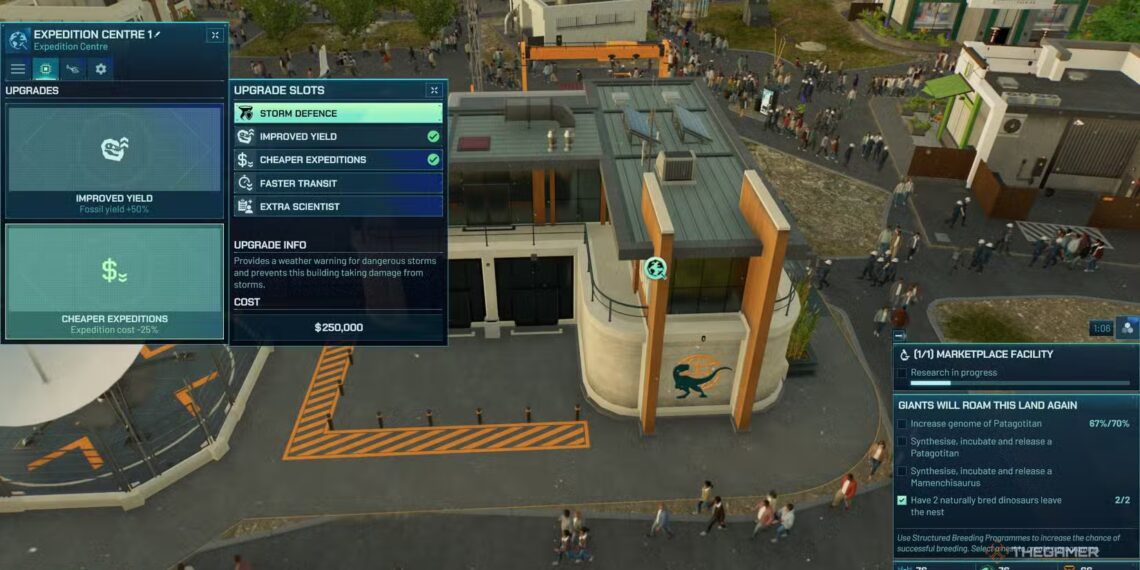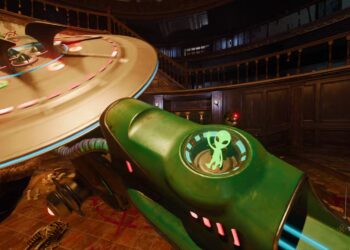Select Language:
Without excavations at various sites worldwide, dinosaurs and reptiles wouldn’t be part of Jurassic World. The fossils retrieved by your scientists in Jurassic World Evolution 3 are crucial for studying genetic data needed to create new creatures.
As you develop each park, your teams will gain more knowledge and discover additional excavation sites filled with fossils to analyze and valuable materials to sell. Here’s everything you need to know about organizing expeditions and handling fossils in Jurassic World Evolution 3.
How to Organize Expeditions in Jurassic World Evolution 3
In Jurassic World Evolution 3, expeditions are managed through the Expedition Center. This structure costs $75,000 and needs two units of power. Place it close to a Backup Generator or a Substation connected to a Power Station. To ensure everything runs smoothly, your park should also have a Maintenance Facility and a Maintenance Post near the Expedition Center and Power Plant, with a Maintenance Team assigned.
Once powered, hire scientists and set up a lab where they can extract DNA from fossils collected during digs. To hire staff, build a Staff Center costing $45,000. This facility trains your scientists, boosting their skills to research rare dinosaurs more efficiently, reducing the number of scientists needed per project.
Additionally, you’ll need a Science Center for analyzing fossils once your team returns from expeditions and for selling extra minerals found. Extracting genomes requires a scientist or two with specific Genetics skill points.
Expeditions are launched from the Expedition Center or via the Expedition Map in the Control Room. Early on, you’ll have limited dig sites, but more will unlock as you progress. Hover over map markers to see what fossils are available, the cost of the expedition, and the skill requirements for success.
When a dig site is fully explored—meaning you’ve collected 100% of its genomes—the marker turns green, and you can no longer revisit that site.
You can enhance expeditions by adding upgrades to the Expedition Center, such as faster results, storm defenses, or extra scientists. These upgrades cost money but can make your expeditions quicker or more affordable over time.
How to Unlock All Dig Sites
More excavation sites become available as you complete objectives across your parks worldwide. Initially, you have access to a few sites, but more open up, allowing you to retrieve genomes of various reptiles and dinosaurs.
| Dig Site | Rewards | Unlock Requirements |
|---|---|---|
| Carnivores | Compsognathus, Dilophosaurus | Starting point |
| Herbivores | Edmontosaurus, Galimimus, Lystrosaurus | Starting point |
| Tiny Herbivores | Microceratus, Psittacosaurus, Protoceratops | Progress through Kauai, Hawaii |
| Small Herbivores 1 | Struthiomimus, Pachycephalosaurus, Ornithomimus | Progress through Kauai, Hawaii |
| Small Herbivores 2 | Homalocephale, Stygimoloch, Archaeornithominus, Dryosaurus | Progress through Kauai, Hawaii |
| Medium Herbivores 1 | Maiasaura, Corythosaurus | Progress through Kauai, Hawaii |
| Medium Herbivores 2 | Iguanodon, Olorotitan, Parasaurolophus, Muttaburrasaurus, Tsintausaurus | Progress through Kauai, Hawaii |
| Medium Herbivores 3 | Therizinosaurus | Progress through Sichuan Basin, China |
| Large Herbivores 1 | Aatosaurus, Brachiosaurus, Patagotitan | Progress through Sichuan Basin, China |
| Large Herbivores 2 | Diplodocus, Mamenchisaurus, Dreadnoughtus | Progress through Kauai, Hawaii |
| Armored Herbivores 1 | Ankylosaurus, Nodosaurus, Chungkingosaurus | Progress through Kauai, Hawaii |
| Armored Herbivores 2 | Nasutoceratops, Sinoceratops, Styracosaurus, Triceratops, Lokiceratops | Progress through Kauai, Hawaii |
| Armored Herbivores 3 | Stegosaurus, Chasmosaurus, Gigantspinosaurus, Sauropelta | Progress through The Azores Islands, Portugal |
| Piscivores | Spinosaurus, Baryonyx, Suchomimus | Progress through Katsuyama, Japan |
| Omnivores | Oviraptor | Progress through Kauai, Hawaii |
| Tiny Carnivores | Moros Intrepidus, Proceratosaurus | Achieve Security Reputation of 15 |
| Small Carnivores 1 | Dimetrodon, Atrociraptor, Pyroraptor, Deinonychus | Progress through Katsuyama, Japan |
| Small Carnivores 2 | Guanlong, Herrerasaurus, Velociraptor, Coelophysis, Troodon | Progress through Kauai, Hawaii |
| Medium Carnivores 1 | Allosaurus, Ceratosaurus, Utahraptor, Metriacanthosaurus | Achieve Security Reputation of 35 |
| Medium Carnivores 2 | Concavenator, Yutyrannus, Albertosaurus | Progress through Kauai, Hawaii |
| Large Carnivores | Giganotosaurus, Tyrannosaurus rex, Carnotaurus, Acrocanthosaurus, Qianzhousaurus | Achieve Security Reputation of 55 |
| Marine Animals 1 | Ichthyosaurus, Plesiosaurus, Kronosaurus, Dunkleosteus | Progress through Kauai, Hawaii |
| Marine Animals 2 | Mosasaurus, Attenborosaurus, Megalodon | Progress through Sichuan Basin, China |
| Flying Reptiles 1 | Dimorphodon, Tapejara, Caiuajara | Progress through Clark County, Nevada |
| Flying Reptiles 2 | Pteranodon, Tropeognathus, Geosternbergia | Progress through Kauai, Hawaii |
| Flying Reptiles 3 | Quetzelcoatlus, Thanatosdrakon | Progress through Kauai, Hawaii |
Exploring new sites depends on completing park objectives worldwide. Your initial options are limited but expand as you reach milestones, allowing you to get genomes from a variety of dinosaurs and reptiles.







